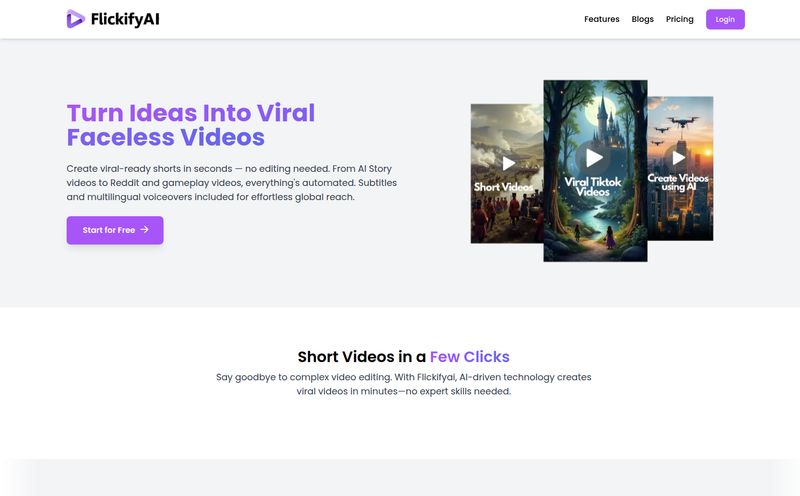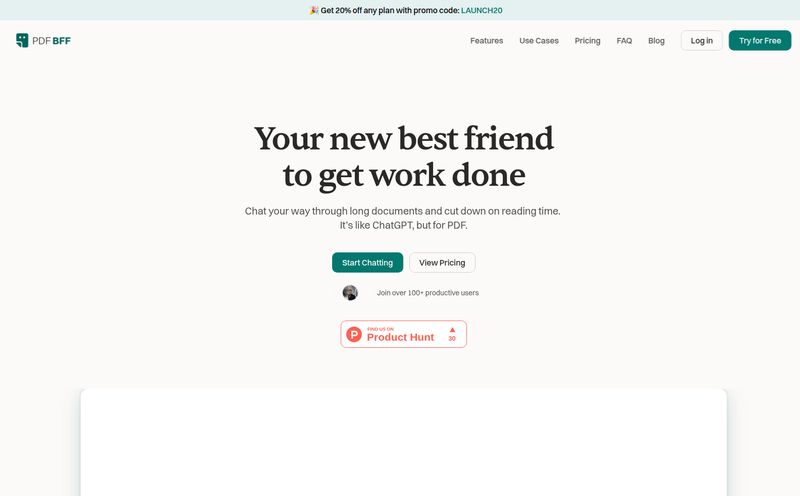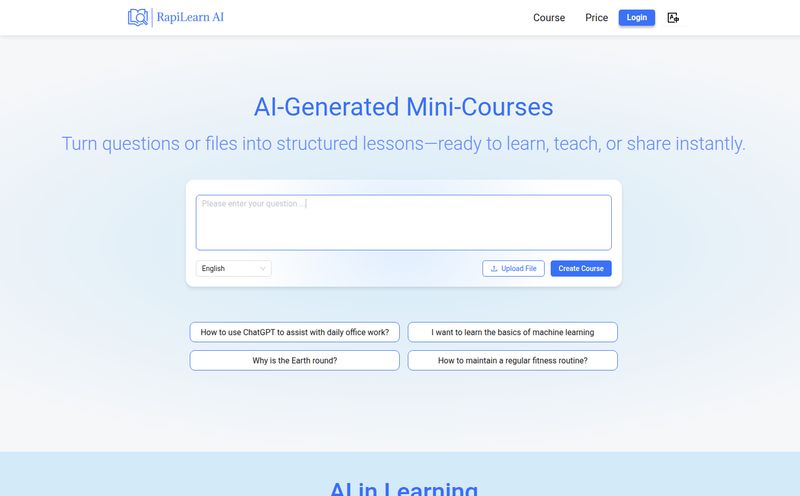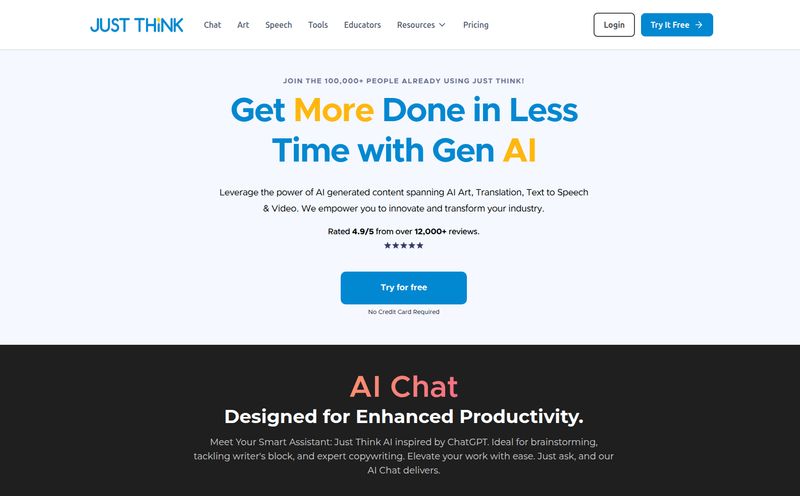How many of you have a folder on your computer filled with interview audio, podcast recordings, or webinar videos that you SWEAR you’re going to transcribe “one day”? Yeah, me too. The thought of sitting there with headphones, pausing every five seconds to type out what was said… it’s a modern form of torture. It’s right up there with untangling Christmas lights in July.
For years, we've bounced between clunky software and expensive services. Then came the wave of AI transcription tools, which was great, but they often roped you into yet another monthly subscription. You know the drill. That $15 a month you forget about until you check your bank statement. I’ve been looking for something different, something that doesn’t feel like a long-term commitment I didn’t ask for.
And I think I may have stumbled upon it. It's called PlainScribe, and its whole philosophy seems to be built around simplicity and paying for only what you actually use. So, does it live up to the hype? Let’s get into it.
So What Exactly Is PlainScribe?
On the surface, PlainScribe does what a lot of other tools do: it takes your audio and video files and turns them into text. But it’s the how and the what else that caught my eye. It’s not just a one-trick pony. The platform is built on three core pillars: Transcribe, Translate, and Summarize.
Imagine you just finished a fantastic 45-minute podcast interview. You can upload that MP3 to PlainScribe, and it will spit out a full text transcript. Cool. But then, with a click, you can translate that entire transcript into Spanish, French, or Japanese to reach a wider audience. And if you're in a hurry, you can ask its AI to generate a summary of the whole conversation, pulling out the key points and action items. Suddenly, that single piece of audio has been repurposed into three different assets. That’s efficiency.
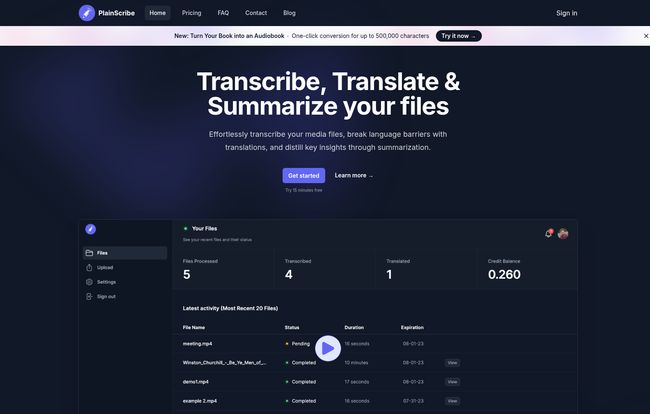
Visit PlainScribe
The Features That Actually Matter
Let's break down the toolkit. It's easy to get lost in a sea of features, but here’s what I found genuinely useful.
From Audio to Text Without the Fuss
The main event, of course, is the transcription. In my tests, the accuracy was pretty solid. It’s not perfect—no AI is, especially with thick accents or poor audio quality—but it’s certainly on par with some of the bigger names in the space. It handles both audio and video files, which is a must-have. You get a clean, timestamped transcript that’s easy to read and edit. No more guessing who said what and when.
Breaking Down Language Barriers
This is a big one. The ability to translate to over 50 languages is a game-changer for creators looking to go global. Think about it: you can take your English-language YouTube video, use PlainScribe to get an SRT subtitle file, translate it to Portuguese, and instantly open your content up to the massive Brazilian market. It’s a ridiculously simple way to expand your reach.
The AI-Powered Summary is Your Personal Assistant
I was skeptical about the summarization feature, but it's surprisingly clever. The "Smart Notes Enhancement" uses AI to pull out the most important themes, questions and insights. It's like having an assistant who listened to the whole thing and gave you teh cliff notes. For long-form content like lectures or brainstorming sessions, this feature alone could save you hours of re-listening and note-taking.
Exporting for the Real World
A transcript is useless if it’s trapped inside the platform. PlainScribe gets this. You can download your work as a simple text file, a CSV for data analysis, or, crucially, as SRT/VTT subtitle files. For any video creator, this is gold. Getting accurate, timed subtitles is often a painstaking process, and this makes it almost trivial.
Let's Talk Money: The Beauty of Pay-As-You-Go
Okay, this is my favorite part. I have a serious case of subscription fatigue. From streaming services to productivity tools, it feels like every company wants a piece of my monthly budget. PlainScribe sidesteps this entirely with a Pay-As-You-Go model.
There are no monthly fees. No tiers. No lock-ins. You simply buy credits as you need them. The pricing is refreshingly transparent:
| Service | Cost per Minute | Purchase Unit |
|---|---|---|
| Transcribe, Translate & Summarize | $0.067 / minute | $10 for 150 minutes of credits |
You pay $10, you get 150 minutes of processing time. Use them this week, next month, or next year. This model is perfect for freelancers, students, or small businesses who don’t have a constant, predictable need for transcription every single month. Sometimes you have five interviews in a week; other times, you have none for a month. Why pay for the downtime? This just makes sense.
The Good, The Bad, and The Nitty-Gritty
No tool is perfect, so let's get real. Here’s my honest breakdown.
The Wins
The biggest pro is the pricing freedom. It's a breath of fresh air. The accuracy is strong, the translation feature is a massive value-add, and the user interface is clean and dead simple. But there's a hidden gem: privacy. PlainScribe states that they automatically delete your files and data after 7 days. In an age where we’re all (rightfully) paranoid about where our data goes, this is a huge trust signal. I really appreciate that.
The Heads-Ups
There are a few limitations. The 100MB file size limit could be an issue for people working with high-resolution, long-form video. For most podcasters or interviewers using audio, it’s probably fine. Also, while the per-minute cost is low, if you were a massive corporation needing to transcribe thousands of hours, the cost could add up. This tool isn't really built for that scale. Finally, you have to sign in to buy credits, which is a tiny, tiny hurdle, but worth mentioning for those who despise creating new accounts.
Who Is This For? (And Who Should Pass?)
I see PlainScribe as the perfect tool for a specific group of people.
- Content Creators (Podcasters, YouTubers): The easy creation of transcripts and SRT files in multiple languages is a killer workflow enhancement.
- Students and Researchers: Quickly transcribe lectures and interviews for analysis without committing to a monthly fee on a student budget.
- Marketers and UX Researchers: Analyze customer feedback calls or user testing sessions efficiently with transcription and summarization.
- The Occasional User: Anyone who needs to transcribe something once in a blue moon and doesn't want another subscription haunting their credit card.
Who isn't it for? Probably large enterprises that need team accounts, advanced collaboration features, and dedicated support. They might be better served by a more corporate-focused (and expensive) solution.
My Final Take
I like tools that do a job well without a lot of fuss. PlainScribe fits that bill perfectly. It's a sharp, focused service that knows its audience: people who need high-quality transcription, translation, and summarization without the contractual baggage.
It’s not trying to be everything to everyone. It’s a specialist. A reliable tool you can pull out of your digital toolbox when you need it and forget about when you don’t—and it won't keep charging you. For me, that's more than just a feature; it's a sign of respect for the customer. In today's SaaS market, that’s something worth paying for. Or, in this case, not paying for every month.
Frequently Asked Questions
- How does PlainScribe's pricing work?
- It's a simple pay-as-you-go system. You buy credits in batches—for example, $10 gets you 150 minutes of processing time. There are no monthly subscriptions or hidden fees. You only pay for what you use.
- Is my data safe with PlainScribe?
- Yes, data privacy is a key feature. PlainScribe automatically deletes your uploaded files and the resulting transcripts from their servers 7 days after processing, ensuring your information remains private.
- What file formats can I export my transcripts in?
- You can export your transcripts as plain text (.txt), CSV for spreadsheet use, and subtitle formats like SRT and VTT, which are perfect for adding captions to videos.
- How many languages does PlainScribe support for translation?
- PlainScribe supports translation into more than 50 different languages, making it a great tool for creating content for a global audience.
- What is the maximum file size I can upload?
- The current maximum file size is 100MB. This is generally sufficient for most audio files and standard-definition video, but could be a limitation for very long 4K video files.
- Can the AI summarize a very long video or audio file?
- Yes, as long as the file is within the size limit, the AI can process it and generate a summary. This is particularly useful for getting the key takeaways from lengthy content like webinars or multi-hour interviews.
